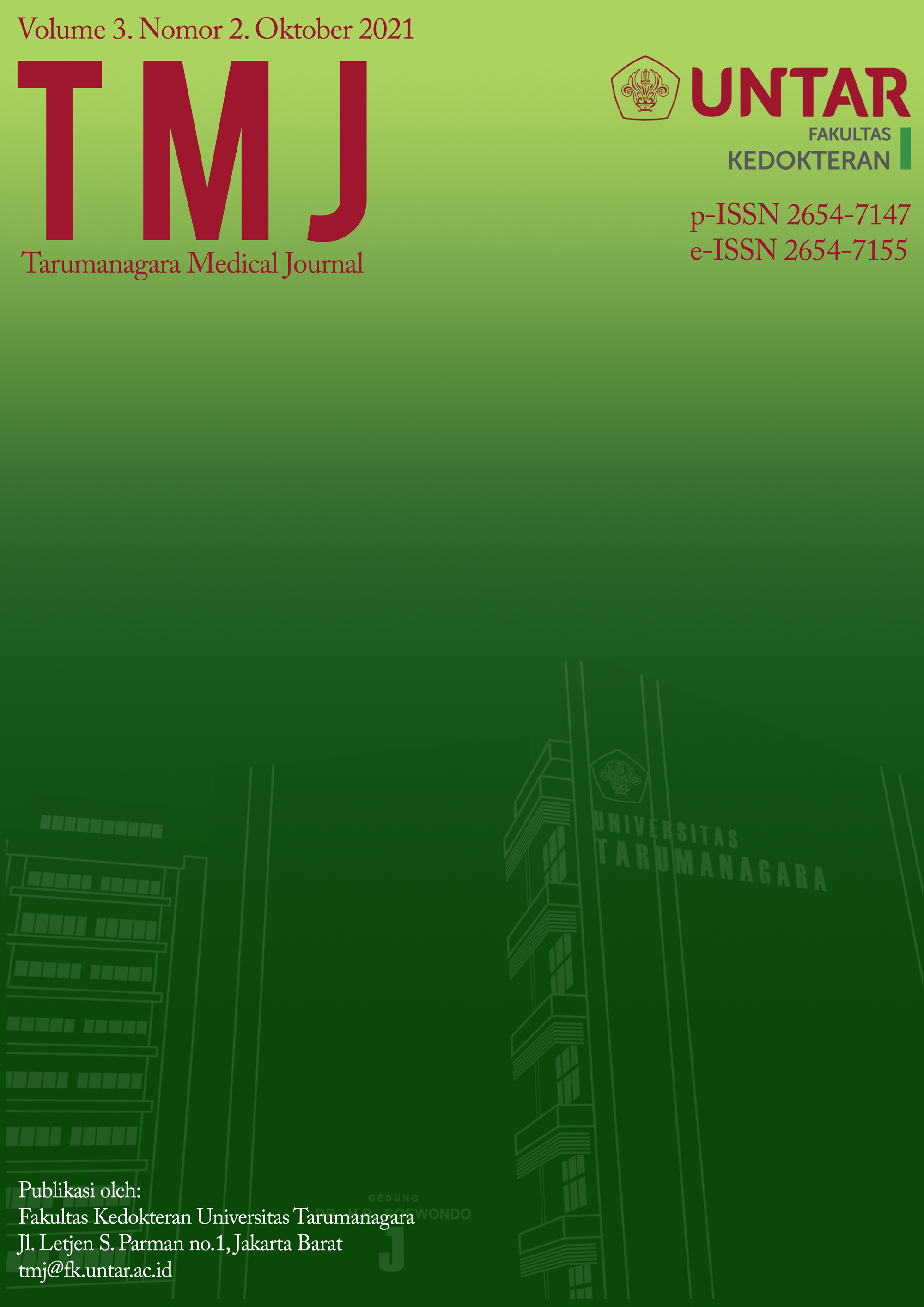Factors influenced of drug-resistant tuberculosis and non-drug-resistant tuberculosis patients in Pulmonary Hospital Dr. M. Goenawan Partowidigdo, Bogor district
Main Article Content
Abstract
Tuberculosis is one cause of death, the ninth of all diseases in the world. The increasing cases of antimicrobial-resistant tuberculosis is a global challenge especially multi-drug resistant TB (MDR-TB). Drug-resistant Tuberculosis is classified as a condition where Mycobacterium tuberculosis can’t be treated with anti-tuberculosis drugs. The study aimed to determine the associated risk factors with drug-resistant Tuberculosis compared with second category tuberculosis (non-drug resistant Tuberculosis). A case-control study was undertaken — there were 40 cases (drug-resistant TB) and 80 controls (non-drug resistant TB) were conveniently sampled. Data we collected from medical records and direct interviews using questionnaires. The variables of interest were gender, age, occupation, income, medication history, side effects, regularity of taking medication, nutritional status, smoking, alcohol, contact history, treatment chronology, and health facility distance. The results showed majority of respondents were mostly men, age >41 years, low education, work, incomes >1.00,000 IDR, failed/discontinued treatment, no side effects, adherence treatment, BMI> 18.5, no smoking, no alcohol consumption, no contact history, lack of knowledge, drug swallowing supervisor (DSS), health services distance <3 km. Final model adherence of treatment p-value 0.0001, OR 6.460, 95% CI 2.384-17.504; contact history p-value 0.004, OR 4.549, 95% CI 1.623-12.748; side effects p-value 0.017, OR 3.580, 95% CI 1.260-10.17; health service distance p-value 0.061, OR 2.627, 95% CI 0.955-7.226. These four factors have contributed to the occurrence of drug-resistance TB.
Article Details

This work is licensed under a Creative Commons Attribution-NonCommercial-ShareAlike 4.0 International License.
Penulis yang menerbitkan artikelnya di Tarumanagara Medical Journal (TMJ) setuju dengan ketentuan sebagai berikut:
- Penulis mempertahankan hak cipta dan memberikan jurnal hak publikasi pertama dengan bekerja secara bersamaan dilisensikan di bawah Creative Commons Attribution yang memungkinkan orang lain untuk berbagi karya dengan pengakuan atas kepengarangan dari karya asli dan publikasi dalam jurnal ini.
- Penulis dapat masuk ke dalam pengaturan kontrak tambahan yang terpisah untuk distribusi non-eksklusif jurnal versi pekerjaan yang dipublikasikan (misalnya, memposting ke repositori institusional atau menerbitkannya dalam buku), dengan pengakuan publikasi awal dalam jurnal ini.
- Setiap teks yang dikirim harus disertai dengan "Perjanjian Transfer Hak Cipta" yang dapat diunduh melalui tautan berikut: Unduh
References
World Health Organization. Global Tuberculosis Report 2017. [Internet]. Gneva: WHO Press. 2017. Available from: http://www.who.int/tb/publications/global_report/gtbr2017_main_text.pdf
Budijanto D, Yudianto, Hardhana B, Soenardi TA.Profil Kesehatan Indonesia Tahun 2015. [Internet]. Jakarta: Kemenkes RI. 2016. Available from: https://pusdatin.kemkes.go.id/resources/download/pusdatin/profil-kesehatan-indonesia/Profil-Kesehatan-Indonesia-Tahun-2015.pdf
Demile B, Zenebu A, Shewaye H, Xia S, Guadie A. Risk factors associated with multidrug-resistant tuberculosis (MDR-TB) in a tertiary armed force referral and teaching hospital, Ethiopia. BMC Infectious Disease. 2018;18:249.
Fauziah LA, Sudaryo MK. Faktor-faktor yang berpengaruh terhadap kejadian tuberculosis multidrug resistant (TB-MDR) di RSUP Persahabatan tahun 2013. [Internet]. FKUI. 2013. Available from:Jurnal Ilmiah Ilmu Sosial dan Ilmu http://lib.ui.ac.id/naskahringkas/2015-09/S52672-Lia%20Alfiana%20Fauziah
Linda DO. Hubungan karakteristik klien tuberculosis dengan pengetahuan tentang multidrug resistant Tuberkulosis (MDR-TB) di Poli Paru Puskesmas Kecamatan Jagakarsa. [Skripsi]. Jakarta: Fakultas Ilmu keperawatan Universitas Indonesia. 2012.
Hidayathillah AP. Indeks Kejadian Tuberkulosis resisten obat (TB-MDR) pada penderita tuberkulosisi di Kabupaten Gresik Jawa Timur. [Tesis]. Surabaya: FKM Universitas Airlangga. 2016.
Stosic M, Vukovic D, Babic D, Antonijevic G, Foley KL, Vujcic I, et al. Risk factors for multidrug-resistant tuberculosis among tuberculosis patients in Serbia: a care-control study. BMC Public Health. 2018;18(1):1114
Girum T, Muktar E, Lentiro K, Wondiye H, Shewangizaw M. Epidemiology of multidrug-resistant tuberculosis (MDR-TB) in Ethiopia: a systematic review and metaanalysis of the prevalence, determinants and treatment outcome. Trop Dis Travel Med Vaccines. 2018;14(4):5.
Andriyanti AS. Faktor risiko kejadian tuberculosis resisten obat ganda (TB-ROG). Bandung: Universitas Padjajaran. 2014. Available from: http://pustaka.unpad.ac.id/wp-content/uploads/2014/04/Faktor-Risiko-Kejadian-Tuberkulosis-Resisten.pdf
Bello SI, Itiola OA. Drug adherence amongst tuberculosis patients in the University of Ilorin, Nigeria. African Journal of Pharmacy and Pharmacology. 2010;4 (3):109-14.
Asgedom SW, Teweldemedhin M, Gebreyesus H. Prevalence of multidrug-resistent tuberculosis and assicoated factors in Ethipia: A systematic review. J Pathog. 2018;2018: 7104921.
Marahatta SB, Kaewkungwal J, Ramasoota P, Singhasivanon. Risk factor of multidrug resistant tuberculosis in Central Nepal: a pilot study. Kathmandu Univ. Med J (KUMJ). Oct-Des 2010; 8(32): 392-7.
Bumbunan S, Fatmawati Rahmaniah SE. Peran pengawas menelan obat (PMO) terhadap pengobatan penderita tuberkulosa di Wilayah Unit Kerja Pengobatan Penyakit Paru-paru (UP4) Pontianak Jurnal Ilmiah Ilmu Sosial dan Ilmu politik universitasnTanjungpura.2017; 1-21.
Diani A, Darmawan B, Nur hamza W. Prporsi infeksi tuberculosis dan gambaran faktor risikopada bayi yang tinggal dalam satu rumah dengan pasien tuberculosis paru dewasa. SariPediatri. 2016
Putri VA, Yovi IY, Fauzia D. Profil pasien tuberculosis multidrug resistance (TB-MDR) di poliklinik TB-MDR RSUD Arifin Achmad Provinsi Riau periode April 2013- Juni 2014. Jurnal online mahasiswa FK. 2015;2(2):1-17.



